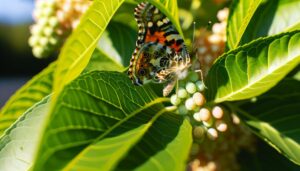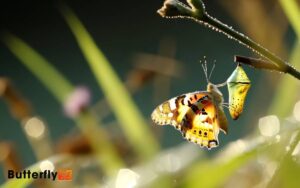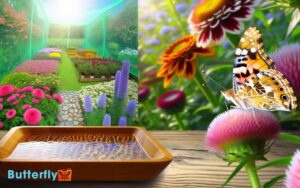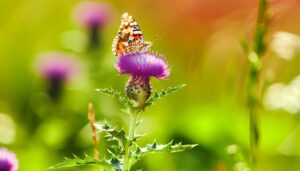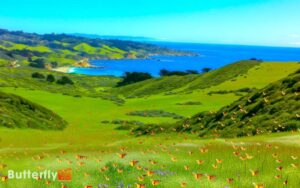Are Painted Lady Butterflies Invasive? Understanding Impact!
Painted Lady butterflies (Vanessa cardui) exhibit resilient adaptability and thrive in diverse climates, migrating thousands of miles annually.
They inhabit every continent except Antarctica and rapidly expand populations due to high fecundity. However, they aren’t classified as invasive despite their ubiquitous presence.
Their ecological role includes pollination and acting as prey for various species, contributing to biodiversity. They interact with local species, influencing plant dynamics through herbivory and competing with other pollinators.
Monitoring and adaptive management can guarantee balanced ecosystems continue to thrive. Learn more about their intriguing impact and management to gain deeper insights into their ecological roles.
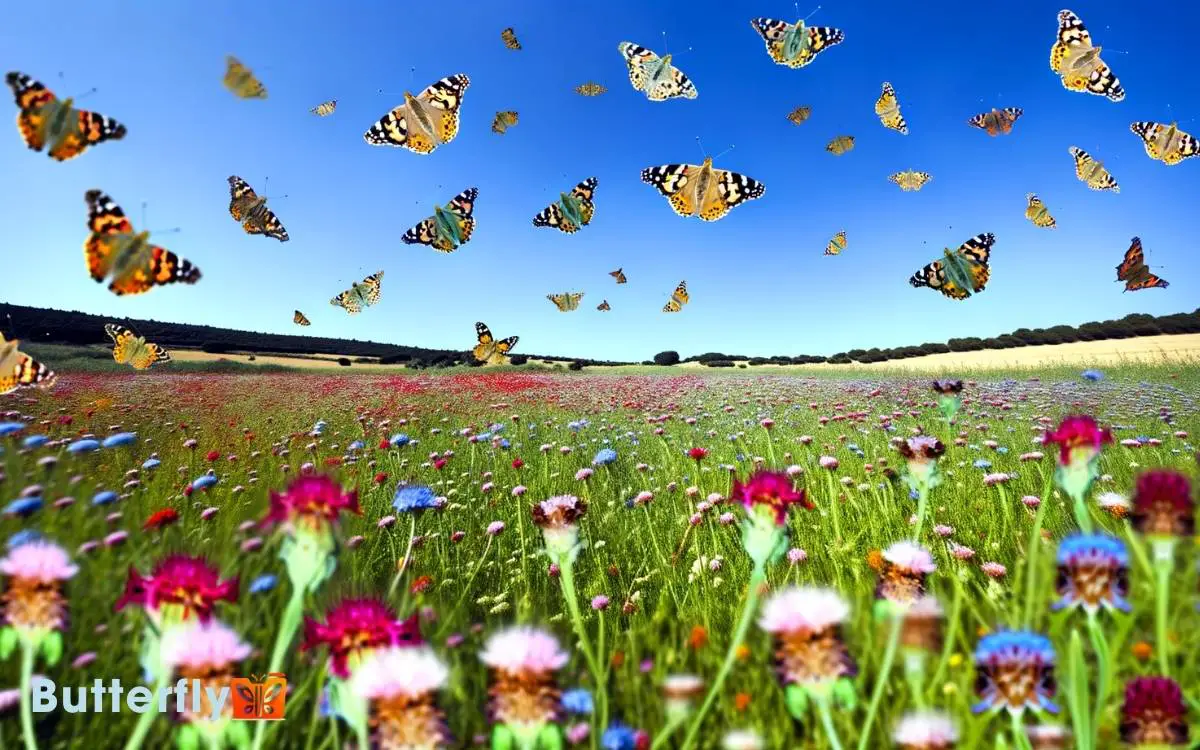
Key Takeaways
Painted Lady Butterfly Overview
The Painted Lady butterfly (Vanessa cardui) is a cosmopolitan species known for its extensive migratory patterns and adaptability to diverse habitats.
This lepidopteran exhibits remarkable resilience, thriving in varied environments ranging from temperate to tropical regions.
A study by Stefanescu et al. (2007) demonstrated that Vanessa cardui undertakes seasonal migrations, traveling distances up to 15,000 kilometers.
Their lifecycle includes four distinct stages: egg, larva, pupa, and adult, each contributing to their survival and proliferation. Larvae mainly feed on a wide array of host plants, including thistles and legumes, enhancing their adaptability.
Additionally, their rapid reproductive cycle, with multiple generations per year, enables swift population expansion. These characteristics underscore their ecological plasticity, making them a species of significant interest to entomologists.
Global Distribution
Vanessa cardui exhibits a global distribution, inhabiting every continent except Antarctica, which underscores its significant ecological versatility.
This species thrives in diverse climates, from tropical to temperate regions. Its extensive migratory patterns further facilitate widespread colonization. Studies indicate high population densities in North America, Europe, Asia, and Africa.
The table below highlights key distribution regions and respective population trends.
| Continent | Population Trend |
|---|---|
| North America | Stable to Increasing |
| Europe | Fluctuating |
| Asia | Increasing |
| Africa | Increasing |
These population trends illustrate the species’ adaptability to various environmental conditions. The Painted Lady’s ability to exploit multiple habitats allows it to maintain substantial populations across vast geographical areas.
Understanding this distribution is vital for evaluating its potential invasiveness and ecological impact.
Life Cycle
Examining the global distribution of Painted Lady butterflies provides essential context for understanding their complex life cycle stages, from egg to adult.
Females lay eggs on host plants, primarily from the Asteraceae family. Each egg hatches into a larva within 5-7 days, initiating the caterpillar stage.
Larvae exhibit five instar phases over approximately 12-18 days, during which they consume large quantities of foliage.
Post-larval development, caterpillars form a chrysalis, entering the pupal stage for about 7-10 days. Within this period, metamorphosis occurs, transforming them into adult butterflies.
Adults emerge, displaying vibrant wing patterns and begin the reproductive cycle anew. Understanding these stages elucidates their resilience and adaptability, essential factors in evaluating their invasive potential.
Migration Patterns
Painted Lady butterflies exhibit remarkable migration patterns that span thousands of miles, demonstrating a unique adaptability and resilience in various environmental conditions.
These Lepidoptera undertake extensive north-south migrations, often traveling from North Africa to Northern Europe. A 2008 study revealed that they cover up to 15,000 kilometers annually, crossing seas and mountain ranges.
Their ability to exploit different habitats and climatic zones underpins their migration success. Utilizing favorable wind currents, they achieve sustained flight speeds of up to 30 kilometers per hour.
Unlike monarch butterflies, Painted Lady migrations are multi-generational, with successive generations continuing the journey.
This migratory behavior showcases a sophisticated navigational strategy, highlighting their ecological plasticity and contributing to their widespread distribution.
Native Vs. Non-Native Habitats
Their extensive migration patterns enable Painted Lady butterflies to occupy both native and non-native habitats, showcasing their remarkable ecological adaptability.
Native to temperate regions, these butterflies frequently migrate to diverse environments, including North America, Europe, and parts of Asia and Africa.
Research indicates that their larval host plants, mainly thistles (Cirsium spp.) and mallows (Malva spp.), are widespread, facilitating their successful colonization across varied ecosystems.
Studies show that Painted Lady populations can thrive in non-native habitats without majorly disrupting local biodiversity. However, their presence in non-native regions can still alter plant-pollinator interactions.
Ecological Role
Understanding the ecological role of Painted Lady butterflies involves analyzing their interactions with various trophic levels, including their contributions to pollination networks and their place in the food web.
These butterflies serve multiple functions within ecosystems:
- Pollination: Painted Ladies assist in the pollination of a variety of plant species, enhancing biodiversity.
- Prey: They act as a food source for predators such as birds, spiders, and other insects.
- Herbivory: Larvae consume host plants, influencing plant community dynamics.
- Parasite Hosts: They harbor parasitoids, contributing to the population control of other insect species.
These roles highlight the intricate balance Painted Ladies maintain within ecosystems, making them integral to ecological stability and biodiversity. Their presence impacts multiple facets of ecological networks.
Impact on Local Flora
The larvae of Painted Lady butterflies, Vanessa cardui, can greatly change local flora by consuming large quantities of host plants, which may lead to shifts in plant community compositions and dynamics.
Their feeding behavior often targets multiple plant species, reducing biomass and altering competitive balances.
Data indicate significant defoliation in certain ecosystems, particularly affecting Asteraceae family members. The resulting decrease in plant diversity can have cascading effects on the entire ecosystem.
| Flora Impact | Observation |
|---|---|
| Host Plant Consumption | High defoliation rates, especially in Asteraceae |
| Plant Community Shifts | Altered competitive balances among species |
| Biomass Reduction | Decreased overall plant biomass |
These alterations highlight the potential for Vanessa cardui to influence plant community structures, indicating a need for further ecological impact assessments.
Interactions With Other Species
Painted Lady butterflies often engage in complex interactions with other species, including predators, parasitoids, and competitors, which can have a significant impact on local biodiversity and ecosystem dynamics.
These interactions include:
- Predation: Birds, spiders, and ants frequently prey on Painted Lady larvae and adults, influencing their population dynamics.
- Parasitism: Parasitoid wasps often lay eggs in Painted Lady larvae, which can lead to high mortality rates.
- Competition: Painted Lady butterflies compete with other pollinators for nectar, potentially altering local pollination networks.
- Mutualism: They also engage in mutualistic relationships with plants by pollinating them, which can enhance plant reproductive success.
Understanding these interactions is essential for evaluating their ecological impact and determining whether they contribute to invasive behavior.
Factors Influencing Population Growth
Interactions with other species greatly impact Painted Lady butterfly populations, but several intrinsic and extrinsic factors also drive their population growth.
Intrinsic factors include reproductive rate and genetic adaptability. Painted Ladies exhibit high fecundity, laying hundreds of eggs, which boosts population size. Moreover, genetic variability enhances their adaptability to diverse environments.
Extrinsic factors encompass climate conditions, availability of host plants, and predation pressures.
Favorable weather patterns, particularly warm temperatures and adequate rainfall, facilitate larval development and increase survival rates. Abundant host plants, such as thistles and mallows, provide essential nutrients for larval growth.
Predation, however, can curtail population expansion. Studies indicate that regions with fewer natural predators experience more substantial population growth, highlighting the intricate balance of ecological influences.
Management and Control Measures
Effective management and control measures for Painted Lady butterflies involve a holistic approach integrating habitat modification, biological control agents, and chemical treatments.
Researchers emphasize the importance of:
- Habitat Modification: Altering the environment to make it less conducive to Painted Lady populations, such as removing host plants.
- Biological Control Agents: Introducing natural predators like parasitic wasps to regulate the butterfly population.
- Chemical Treatments: Applying targeted pesticides to limit larval growth while minimizing environmental impact.
- Monitoring and Data Collection: Continuous observation and data gathering to assess the effectiveness of implemented strategies and make necessary adjustments.
These methods, when combined, offer a comprehensive strategy to manage and control Painted Lady butterfly populations effectively, ensuring ecological balance.
Conclusion
To sum up, painted lady butterflies, with their vast global distribution, complex life cycle, and intricate migration patterns, present a fascinating subject of study. These butterflies are known for their resilience, capable of thriving in diverse environments ranging from meadows to deserts. Researchers have also explored painted lady butterfly toxicity, investigating whether the plants they consume as caterpillars influence their defense mechanisms against predators. Their remarkable adaptability and widespread presence make them a crucial species for studying insect migration and ecological interactions.
Their impact on local flora, interactions with other species, and factors influencing population growth reveal both the beauty and the challenges of their existence.
Balancing their benefits and potential invasiveness necessitates careful management and control measures, ensuring that these vibrant pollinators continue to thrive without disrupting native ecosystems.

